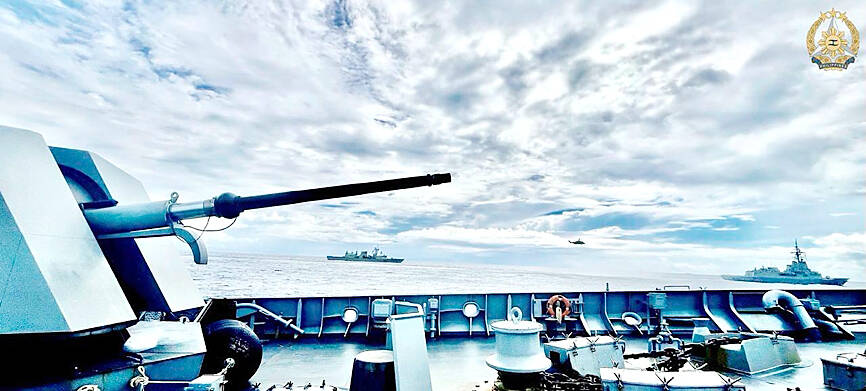The former island paradise of Bikini Atoll is slowing blooming back to life, 70 years after the US dropped 23 nuclear bombs on it, including a device in 1954 that was 1,100 times larger than the atom bomb dropped on Japan’s Hiroshima.
A team of scientists from Stanford University, California, have been surprised to discover an abundance of marine life apparently thriving in the crater of Bikini Atoll, which was declared a nuclear wasteland after the bombings, with its 167 inhabitants relocated to other islands.
Steve Palumbi, a professor in marine sciences at the university, said the effects of radiation poisoning on ocean life have never been studied in-depth, and his team’s initial research suggests it is “remarkably resilient.”
Animals studied by scientists in and around the Chernobyl blast zone in Ukraine showed deformities and mutations, but the Stanford team’s initial research suggests that the marine life in Bikini might have fared significantly better.
RADIOACTIVE COCONUTS
Palumbi’s team discovered a diverse ecosystem of animal life in and around the bomb crater, including coral as big as “cars,” hundreds of schools of fish, including tuna, sharks and snapper, and coconut crabs devouring radioactive coconuts on the shore.
To the naked eye, the crabs, fish and coral of Bikini Atoll look perfectly normal and healthy, and some of the coral has been around for decades — with evidence it might have begun growing as soon as 10 years after the last bombs were dropped, Palumbi said.
“The lagoon is full of schools of fish all swirling around the living coral. In a strange way they are protected by the history of this place, the fish populations are better than in some other places, because they have been left alone, the sharks are more abundant and the coral are big. It is a remarkable environment, quite odd,” he said.
Palumbi’s team concentrated their research efforts on the coral and coconut crabs — which are the size of hubcaps — because they have long life spans, allowing the scientists to delve into what effect the radiation exposure has had on the animals DNA after building up in their systems for many years.
As fish have relatively short life spans, it is possible that the worst-affected fish died off many decades ago, and the fish living in Bikini Atoll today are only subject to low-levels of radiation exposure as they frequently swim in and out of the atoll, Palumbi said.
LONGING TO RETURN
“This is the most destructive thing we have ever done to the ocean, dropping 23 atomic bombs on it, yet the ocean is really striving to come back to life,” Palumbi said. “The fact there is life there and the life there is trying to come back from the most violent thing we’ve ever done to it is pretty hopeful.”
Even though plant, animal and ocean life is showing strong signs of recovery, humans are still unable to live and work on the atoll, besides a few caretakers who bring food and water supplies with them, and keep up the island’s facilities.
A UN report in 2012 said the effects of radiation were long-lasting.
UN Special Rapporteur Calin Georgescu, in a report to the UN Human Rights Council, said “near-irreversible environmental contamination” had led to the loss of livelihoods and many people continued to experience “indefinite displacement.”
The water cannot be drunk because of continued contamination, the seafood cannot be eaten and plants cannot be farmed because of contaminated soil, he said.
More than half of the 167 original inhabitants of Bikini Atoll have now died, and many went to their graves still longing to return to their homeland.
A paper by Georgetown University associate professor of radiation medicine Timothy Jorgensen said that former residents of Bikini Atoll started showing cancers related to radiation exposure in the 1960s.
Those downwind of the explosions had burns and depressed blood counts.
Those on islands further afield showed elevated risk for cancers, particularly thyroid cancers and leukemia, and have been involved in a protracted compensation claim with the US for decades.
CONTAMINATED ISLANDS
“What happened to the Marshall Islanders next is a sad story of their constant relocation from island to island, trying to avoid the radioactivity that lingered for decades,” Jorgensen wrote. “Over the years following the testing, the Marshall Islanders living on the fallout contaminated islands ended up breathing, absorbing, drinking and eating considerable amounts of radioactivity.”

Australia has announced an agreement with the tiny Pacific nation Nauru enabling it to send hundreds of immigrants to the barren island. The deal affects more than 220 immigrants in Australia, including some convicted of serious crimes. Australian Minister of Home Affairs Tony Burke signed the memorandum of understanding on a visit to Nauru, the government said in a statement on Friday. “It contains undertakings for the proper treatment and long-term residence of people who have no legal right to stay in Australia, to be received in Nauru,” it said. “Australia will provide funding to underpin this arrangement and support Nauru’s long-term economic

‘NEO-NAZIS’: A minister described the rally as ‘spreading hate’ and ‘dividing our communities,’ adding that it had been organized and promoted by far-right groups Thousands of Australians joined anti-immigration rallies across the country yesterday that the center-left government condemned, saying they sought to spread hate and were linked to neo-Nazis. “March for Australia” rallies against immigration were held in Sydney, and other state capitals and regional centers, according to the group’s Web site. “Mass migration has torn at the bonds that held our communities together,” the Web site said. The group posted on X on Saturday that the rallies aimed to do “what the mainstream politicians never have the courage to do: demand an end to mass immigration.” The group also said it was concerned about culture,

ANGER: Unrest worsened after a taxi driver was killed by a police vehicle on Thursday, as protesters set alight government buildings across the nation Protests worsened overnight across major cities of Indonesia, far beyond the capital, Jakarta, as demonstrators defied Indonesian President Prabowo Subianto’s call for calm. The most serious unrest was seen in the eastern city of Makassar, while protests also unfolded in Bandung, Surabaya, Solo and Yogyakarta. By yesterday morning, crowds had dispersed in Jakarta. Troops patrolled the streets with tactical vehicles and helped civilians clear trash, although smoke was still rising in various protest sites. Three people died and five were injured in Makassar when protesters set fire to the regional parliament building during a plenary session on Friday evening, according to

STILL AFLOAT: Satellite images show that a Chinese ship damaged in a collision earlier this month was under repair on Hainan, but Beijing has not commented on the incident Australia, Canada and the Philippines on Wednesday deployed three warships and aircraft for drills against simulated aerial threats off a disputed South China Sea shoal where Chinese forces have used risky maneuvers to try to drive away Manila’s aircraft and ships. The Philippine military said the naval drills east of Scarborough Shoal (Huangyan Island, 黃岩島) were concluded safely, and it did not mention any encounter with China’s coast guard, navy or suspected militia ships, which have been closely guarding the uninhabited fishing atoll off northwestern Philippines for years. Chinese officials did not immediately issue any comment on the naval drills, but they